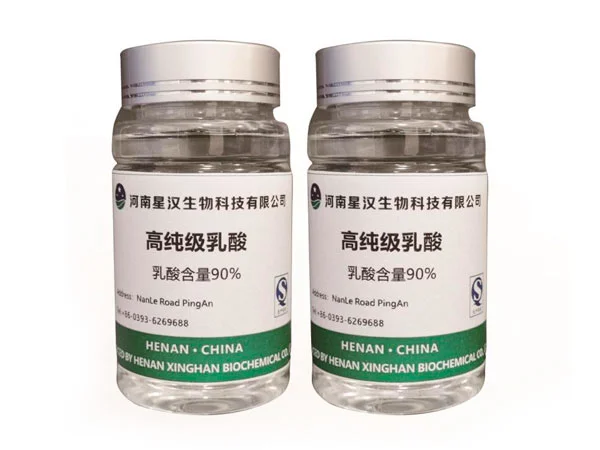High Purity Lactic Acid CAS NO. 79-33-4 Wholesale
https://www.xhlactics.com/products/high-purity-lactic-acid-cas-no-79-33-4/ #lactic #acid #90
The company's high-grade lactic acid (90% lactic acid content) is produced from corn stalks using modern fermentation technology. This product is colorless and clarified viscous liquid, no bad smell, slightly sour taste, hygroscopicity, acidic reaction of aqueous solution, can be mixed with water, ethanol or ether, and is insoluble in chloroform.
Information of High Purity Lactic Acid
The structural formula of lactic acid is CH3CHOHCOOH, the molecular formula C3H6O3, the relative molecular mass is 90.08, and the molecule has both hydroxyl (OH) and carboxyl (COOH) functional groups. It is the most widely existed hydroxycarboxylic acid in nature and the simplest one. Hydroxamic acid. Lactic acid is widely present in animals, plants, and microorganisms. L-lactic acid and L-lactate dehydrogenase capable of metabolizing L-lactic acid are present in tissues of humans and animals, and D-lactate dehydrogenase is absent. The human body ingests L lactic acid, which can be absorbed and decomposed, while D lactic acid can not be decomposed, and it is easy to form D lactic acid enrichment in the body.
Basic Information
Chemical Name
L(S)-2-hydroxy propionic acid
Molecular Formula
CH3CHOHCOOH
Molecular Weight
90.08
Technical Indicator
Identification
The water solution is acidic, lactate presents the positive reaction
lactic acid content, w/%
95.0-105.0 of market value
L-content of lactic acid in the total lactic acid, w/%
≥99.0
Ignition residue, w/%
≤0.01
Chloride (calculated as C1), w/%
≤0.001
Sulfate (calculated as SO4), w/%
≤0.001
Iron salt (calculated as Fe), w/%
≤0.0001
Cyanide, mg/kg
≤1.0
Citric acid, oxalic acid, phosphoric acid, tartaric acid
Passed the experiment
Reducing sugar
Passed the experiment
Readily carbonizable substance
Passed the experiment
Lead (Pb), mg/kg
≤0.5
Arsenic (As), mg/kg
≤1.0
Chroma, APHA
≤10
Heating chroma (180℃ 2hs), APHA
≤10
Mercury (Hg), mg/kg
≤1
Volatile fatty acids
Passed the experiment
Methanol, w/%
≤0.20
Heavy metal (calculated as Pb), mg/kg
≤5
Ether insoluble
Passed the experiment
Calcium salt, mg/kg
≤1
Density (20℃), g/ml
1.200-1.220
High Purity Lactic Acid Applications
High-purity lactic acid is a key ingredient in many industries and applications. It is a versatile, renewable, and sustainable source of acidic compounds in food and beverage, cosmetics, and pharmaceutical applications.
Food and Beverage: High-purity lactic acid is used in food and beverage products as a preservative, flavoring agent, and acidifier. It is a key ingredient in dairy products, including yogurt and cheese, and is used to maintain the pH balance of certain foods.
Cosmetics: High-purity lactic acid is used as an exfoliant in many skin care products, providing a gentle alternative to other physical exfoliants like scrubs and brushes. It is also an emollient in certain cosmetics to improve skin hydration and texture.
Pharmaceuticals: High-purity lactic acid is used to manufacture certain pharmaceuticals, including antifungal agents, antibiotics, and antiviral drugs. It is also used as a preservative in some medicines, as well as in the manufacture of controlled-release drug delivery systems.
High Purity Lactic Acid CAS NO. 79-33-4 Wholesale
https://www.xhlactics.com/products/high-purity-lactic-acid-cas-no-79-33-4/
#lactic #acid #90
The company's high-grade lactic acid (90% lactic acid content) is produced from corn stalks using modern fermentation technology. This product is colorless and clarified viscous liquid, no bad smell, slightly sour taste, hygroscopicity, acidic reaction of aqueous solution, can be mixed with water, ethanol or ether, and is insoluble in chloroform.
Information of High Purity Lactic Acid
The structural formula of lactic acid is CH3CHOHCOOH, the molecular formula C3H6O3, the relative molecular mass is 90.08, and the molecule has both hydroxyl (OH) and carboxyl (COOH) functional groups. It is the most widely existed hydroxycarboxylic acid in nature and the simplest one. Hydroxamic acid. Lactic acid is widely present in animals, plants, and microorganisms. L-lactic acid and L-lactate dehydrogenase capable of metabolizing L-lactic acid are present in tissues of humans and animals, and D-lactate dehydrogenase is absent. The human body ingests L lactic acid, which can be absorbed and decomposed, while D lactic acid can not be decomposed, and it is easy to form D lactic acid enrichment in the body.
Basic Information
Chemical Name
L(S)-2-hydroxy propionic acid
Molecular Formula
CH3CHOHCOOH
Molecular Weight
90.08
Technical Indicator
Identification
The water solution is acidic, lactate presents the positive reaction
lactic acid content, w/%
95.0-105.0 of market value
L-content of lactic acid in the total lactic acid, w/%
≥99.0
Ignition residue, w/%
≤0.01
Chloride (calculated as C1), w/%
≤0.001
Sulfate (calculated as SO4), w/%
≤0.001
Iron salt (calculated as Fe), w/%
≤0.0001
Cyanide, mg/kg
≤1.0
Citric acid, oxalic acid, phosphoric acid, tartaric acid
Passed the experiment
Reducing sugar
Passed the experiment
Readily carbonizable substance
Passed the experiment
Lead (Pb), mg/kg
≤0.5
Arsenic (As), mg/kg
≤1.0
Chroma, APHA
≤10
Heating chroma (180℃ 2hs), APHA
≤10
Mercury (Hg), mg/kg
≤1
Volatile fatty acids
Passed the experiment
Methanol, w/%
≤0.20
Heavy metal (calculated as Pb), mg/kg
≤5
Ether insoluble
Passed the experiment
Calcium salt, mg/kg
≤1
Density (20℃), g/ml
1.200-1.220
High Purity Lactic Acid Applications
High-purity lactic acid is a key ingredient in many industries and applications. It is a versatile, renewable, and sustainable source of acidic compounds in food and beverage, cosmetics, and pharmaceutical applications.
Food and Beverage: High-purity lactic acid is used in food and beverage products as a preservative, flavoring agent, and acidifier. It is a key ingredient in dairy products, including yogurt and cheese, and is used to maintain the pH balance of certain foods.
Cosmetics: High-purity lactic acid is used as an exfoliant in many skin care products, providing a gentle alternative to other physical exfoliants like scrubs and brushes. It is also an emollient in certain cosmetics to improve skin hydration and texture.
Pharmaceuticals: High-purity lactic acid is used to manufacture certain pharmaceuticals, including antifungal agents, antibiotics, and antiviral drugs. It is also used as a preservative in some medicines, as well as in the manufacture of controlled-release drug delivery systems.







